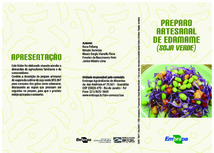Soybean cultivar BRS 267, when harvested green, is consumed with salt as edamame, a popular dish in Japan and other eastern countries. It can also be used as raw material for culinary preparations, snacks, and other handmade and industrialized foods. The cultivar can expand the national market for the product, currently marketed in small scale as edamame, with the potential to compete with soybeans that are imported from China. The technology results from the breeding and genetic improvement program from Embrapa Soybean for the development of special soybeans for human consumption. Belonging to a valued market niche, edamame is a good alternative for organic or family farmers.Belonging to a valued market niche, edamame is a good alternative for organic or family farmers.. The BRS 267 soybean cultivar can expand the consumption of a food that is still little known in Brazil: edamame, green soybean grains served with salt, which is very common in Japan and other Asian countries. The cultivar produces large grains with mild flavor, which show similar texture to other vegetables such as chickpeas, green peas, and some types of beans. Preparation is easy, with fast cooking, and it can be consumed in snacks or compose dishes such as soups and salads. As a potential niche product, soybean cultivation for edamame is a great option for family and organic farmers. The Embrapa researcher José Ubirajara Moreira explains that it is essential to carry out the BRS 267 harvest in the right stage for a product with differentiated sensory and nutritional quality. "It must be harvested in the R6 stage, with formed, green, and completely full seeds. The harvest period is very short and lasts from two to four days", he informs. The Embrapa researcher Ilana Felberg recalls that, like any soybean, the BRS 267 cultivar must be cooked before consumption. Procedures were performed to establish the stages and conditions of the process that can be easily reproduced in kitchens or family agroindustries. "We can cook both the pods or the previously threshed grains. What we did was to assess and verify the effectiveness of cooking time in the inactivation of anti-nutritional factors to make product consumption safe," she says. The step of cooking the pods requires boiling in water. "A period of 20 minutes is suggested. After cooking, it is necessary to drain the water and, after that, dip the container with the pods in cold water or under running water until they are cool, in order to stop cooking and avoid the excessive softening of the pods," the Embrapa researcher Renata Torrezan explains. Edamame Edamame is a traditional food in the East and popular in countries like the United States, Australia, and in Europe. In the Brazilian market the food is found in packages of frozen pods and green grains, mostly imported from China. After removing the excess water, the product can be placed in packages that are appropriate for the type of storage. "The storage can last up to five days in cooling temperatures, between two and eight degrees Celsius, or up to a year in the freezing temperature of minus 18 degrees", Torrezan adds. The researcher warns that even if the processing of the food is made in a small or handmade scale, the edamame needs to go through thermal processing before consumption. The necessary procedures are detailed in the guide “Processamento de edamame em vagens para agroindústria de pequeno porte” [Edamame processing in pods for small-sized agroindustries] and are also subject to city and state sanitary laws. Cultivating soybeans for edamame showed good results in different edaphoclimatic conditions (i.e. different climates and soils). Initially recommended for the Brazilian states of Santa Catarina, Paraná, São Paulo, and south of Mato Grosso do Sul, the cultivar has also had a good performance in Rio de Janeiro. Embrapa Food Technology, located in the capital city of Rio de Janeiro, developed processing protocols using edamame produced in crops within the state through partnerships with farmers. According to the Embrapa researcher Claudia Jantalia, the incidence of soybean pests and diseases has been low because of the absence of soybean crops in the state. She explains that the edaphoclimatic characteristics tested allowed the crop to reduce its cycle in comparison with other regions like Paraná, which makes it an interesting option for the local farmer. The research In 1985, the Embrapa researcher Mercedes Carrão Panizzi started to coordinate a breeding and genetic improvement program in order to obtain soybean cultivars with special characteristics for human consumption and a program to promote the legume for this purpose. "Five cultivars were launched from the project, including BRS 267," the scientist recalls.. "Among the cultivar attributes, the pleasant flavor is the result of the presence of sucrose [sugar], an essential characteristic for edamame," Embrapa researcher Marcelo Álvares de Oliveira, stressing that the cultivar presents resistance to main soybean diseases. The research and technology transfer work gathered teams from four Embrapa units: Embrapa Food Technology (RJ), Embrapa Soybean (PR), Embrapa Wheat (RS) and Embrapa Agrobiology (RJ). The tests with farmers from Rio de Janeiro and Espírito Santo counted on a partnership with the Itaguaí Agriculture Secretariat, the Rio de Janeiro Agricultural Research Company (Pesagro), the Federal Rural University of Rio de Janeiro (UFRRJ), the State University of Northern Rio de Janeiro (UENF) and the Espírito Santo Institute of Research, Technical Assistance and Rural Extension (Incaper). "The experience and interest of organic family farmers are great advantages. It is an opportunity to diversify crop and livestock production with the insertion of this cultivar," highlights the Embrapa researcher Mauro Pinto, who considers the interest of consumers and the ease to prepare soybeans for edamame as important competitive advantages for the expansion of this market. Tests with BRS 267 are also being carried out in São Paulo in a partnership between Embrapa and the São Paulo State Department of Agriculture and Food Supply. "The Agronomic Institute of Campinas (IAC), Embrapa Mid-North and farmers from Cooperativa dos Agricultores Familiares da Região Centro Paulista and Cooperativa Entre Serras e Águas are also involved in the project”, informs Fénelon Neto, researcher from the Technology Transfer area at Embrapa. Seed companies can obtain BRS 267 licensing In order to meet the needs of smallholders (organic and horticultural farmers), Embrapa is strengthening the organization of the seed supply chain for the production of edamame soybeans. During the initial stage, the Corporation is working on two fronts: assisting farmers that are already participating in the program and validating the production technology of edamame; and organizing the seed supply chain for the market, aiming to expand supply. Technicians recall that the technology is destined to a market niche that requires special attention, since the grain is directly consumed and there is value aggregation, and it also involves segregation in seed production. In the 2020/21 crop season, the Corporation carried out the production of the genetic seed of the cultivar, which is later offered to companies and seed farmers that work in the market. In this supply logistics chain, such farmers increase the volume in the following seasons and start to offer the seed of the cultivar to sellt o other farmers. Embrapa is already doing business with other two companies, but remains open to new partnerships to license the material. Seed production companies that are interested in multiplying seeds from BRS 267 can get more information about the cultivar on Embrapa's business web page. In addition to BRS 267 cultivar, Embrapa's breeding and genetic improvement program has a line of development of materials that are specific for human consumption. "The new cultivars that are being developed aim to provide other opportunities for farmers to work in different markets," Moreira underscores.
Photo: Kadijah Suleiman
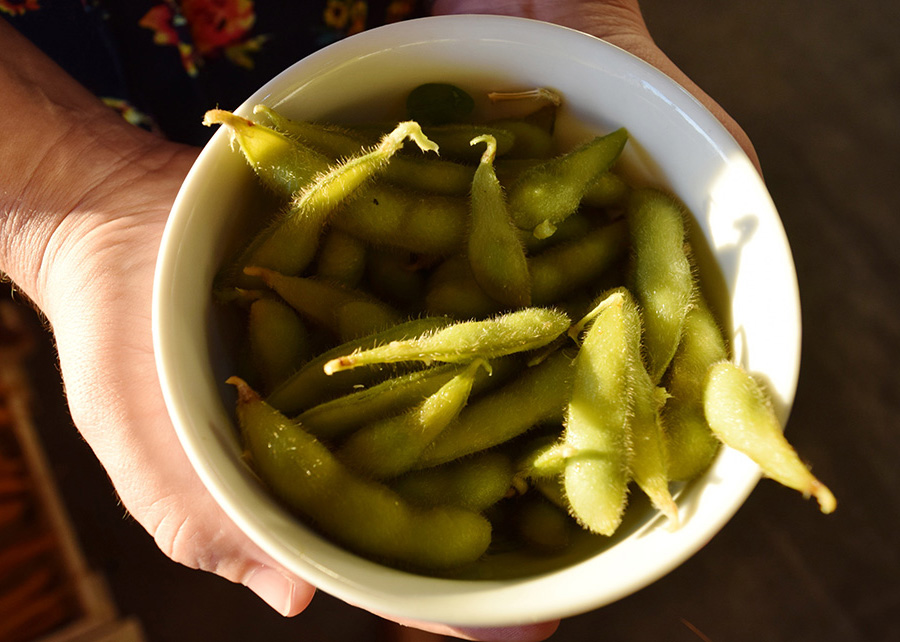
Edamame soybeans can reach specific market niches
-
Soybean cultivar BRS 267, when harvested green, is consumed with salt as edamame, a popular dish in Japan and other eastern countries. -
It can also be used as raw material for culinary preparations, snacks, and other handmade and industrialized foods. -
The cultivar can expand the national market for the product, currently marketed in small scale as edamame, with the potential to compete with soybeans that are imported from China. -
The technology results from the breeding and genetic improvement program from Embrapa Soybean for the development of special soybeans for human consumption. -
Belonging to a valued market niche, edamame is a good alternative for organic or family farmers.Belonging to a valued market niche, edamame is a good alternative for organic or family farmers.. |
The BRS 267 soybean cultivar can expand the consumption of a food that is still little known in Brazil: edamame, green soybean grains served with salt, which is very common in Japan and other Asian countries. The cultivar produces large grains with mild flavor, which show similar texture to other vegetables such as chickpeas, green peas, and some types of beans. Preparation is easy, with fast cooking, and it can be consumed in snacks or compose dishes such as soups and salads.
As a potential niche product, soybean cultivation for edamame is a great option for family and organic farmers. The Embrapa researcher José Ubirajara Moreira explains that it is essential to carry out the BRS 267 harvest in the right stage for a product with differentiated sensory and nutritional quality. "It must be harvested in the R6 stage, with formed, green, and completely full seeds. The harvest period is very short and lasts from two to four days", he informs.
The Embrapa researcher Ilana Felberg recalls that, like any soybean, the BRS 267 cultivar must be cooked before consumption. Procedures were performed to establish the stages and conditions of the process that can be easily reproduced in kitchens or family agroindustries. "We can cook both the pods or the previously threshed grains. What we did was to assess and verify the effectiveness of cooking time in the inactivation of anti-nutritional factors to make product consumption safe," she says.
The step of cooking the pods requires boiling in water. "A period of 20 minutes is suggested. After cooking, it is necessary to drain the water and, after that, dip the container with the pods in cold water or under running water until they are cool, in order to stop cooking and avoid the excessive softening of the pods," the Embrapa researcher Renata Torrezan explains.
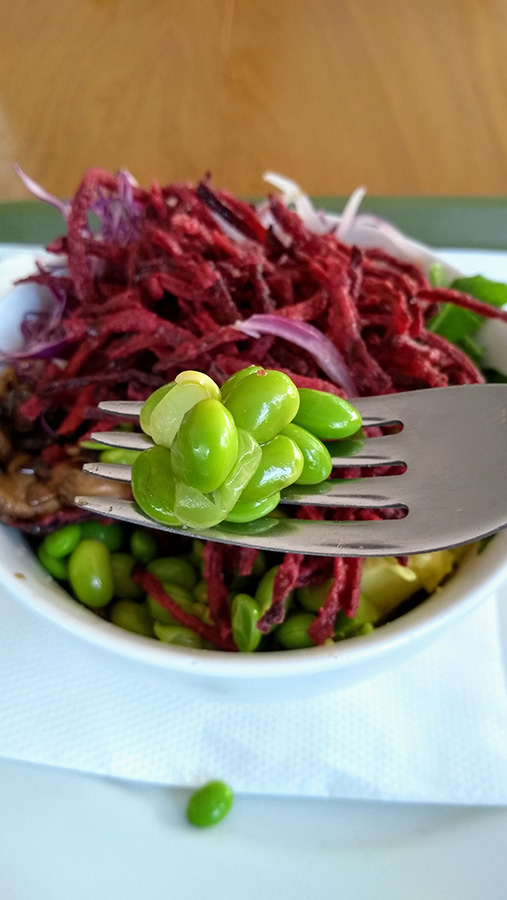
Edamame Edamame is a traditional food in the East and popular in countries like the United States, Australia, and in Europe. In the Brazilian market the food is found in packages of frozen pods and green grains, mostly imported from China. |
After removing the excess water, the product can be placed in packages that are appropriate for the type of storage. "The storage can last up to five days in cooling temperatures, between two and eight degrees Celsius, or up to a year in the freezing temperature of minus 18 degrees", Torrezan adds.
The researcher warns that even if the processing of the food is made in a small or handmade scale, the edamame needs to go through thermal processing before consumption. The necessary procedures are detailed in the guide “Processamento de edamame em vagens para agroindústria de pequeno porte” [Edamame processing in pods for small-sized agroindustries] and are also subject to city and state sanitary laws.
Cultivating soybeans for edamame showed good results in different edaphoclimatic conditions (i.e. different climates and soils). Initially recommended for the Brazilian states of Santa Catarina, Paraná, São Paulo, and south of Mato Grosso do Sul, the cultivar has also had a good performance in Rio de Janeiro. Embrapa Food Technology, located in the capital city of Rio de Janeiro, developed processing protocols using edamame produced in crops within the state through partnerships with farmers.
According to the Embrapa researcher Claudia Jantalia, the incidence of soybean pests and diseases has been low because of the absence of soybean crops in the state. She explains that the edaphoclimatic characteristics tested allowed the crop to reduce its cycle in comparison with other regions like Paraná, which makes it an interesting option for the local farmer.
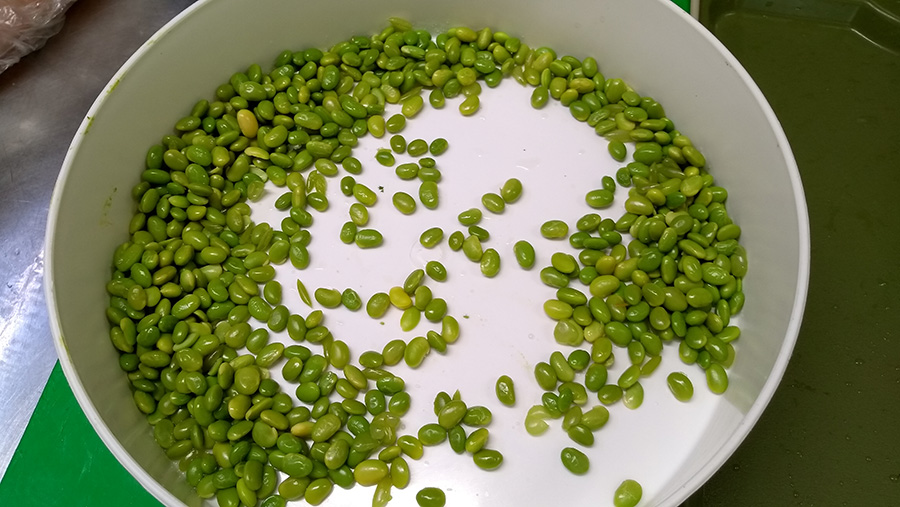 The research The research
In 1985, the Embrapa researcher Mercedes Carrão Panizzi started to coordinate a breeding and genetic improvement program in order to obtain soybean cultivars with special characteristics for human consumption and a program to promote the legume for this purpose. "Five cultivars were launched from the project, including BRS 267," the scientist recalls.. "Among the cultivar attributes, the pleasant flavor is the result of the presence of sucrose [sugar], an essential characteristic for edamame," Embrapa researcher Marcelo Álvares de Oliveira, stressing that the cultivar presents resistance to main soybean diseases. The research and technology transfer work gathered teams from four Embrapa units: Embrapa Food Technology (RJ), Embrapa Soybean (PR), Embrapa Wheat (RS) and Embrapa Agrobiology (RJ). The tests with farmers from Rio de Janeiro and Espírito Santo counted on a partnership with the Itaguaí Agriculture Secretariat, the Rio de Janeiro Agricultural Research Company (Pesagro), the Federal Rural University of Rio de Janeiro (UFRRJ), the State University of Northern Rio de Janeiro (UENF) and the Espírito Santo Institute of Research, Technical Assistance and Rural Extension (Incaper). |
"The experience and interest of organic family farmers are great advantages. It is an opportunity to diversify crop and livestock production with the insertion of this cultivar," highlights the Embrapa researcher Mauro Pinto, who considers the interest of consumers and the ease to prepare soybeans for edamame as important competitive advantages for the expansion of this market.
Tests with BRS 267 are also being carried out in São Paulo in a partnership between Embrapa and the São Paulo State Department of Agriculture and Food Supply. "The Agronomic Institute of Campinas (IAC), Embrapa Mid-North and farmers from Cooperativa dos Agricultores Familiares da Região Centro Paulista and Cooperativa Entre Serras e Águas are also involved in the project”, informs Fénelon Neto, researcher from the Technology Transfer area at Embrapa.
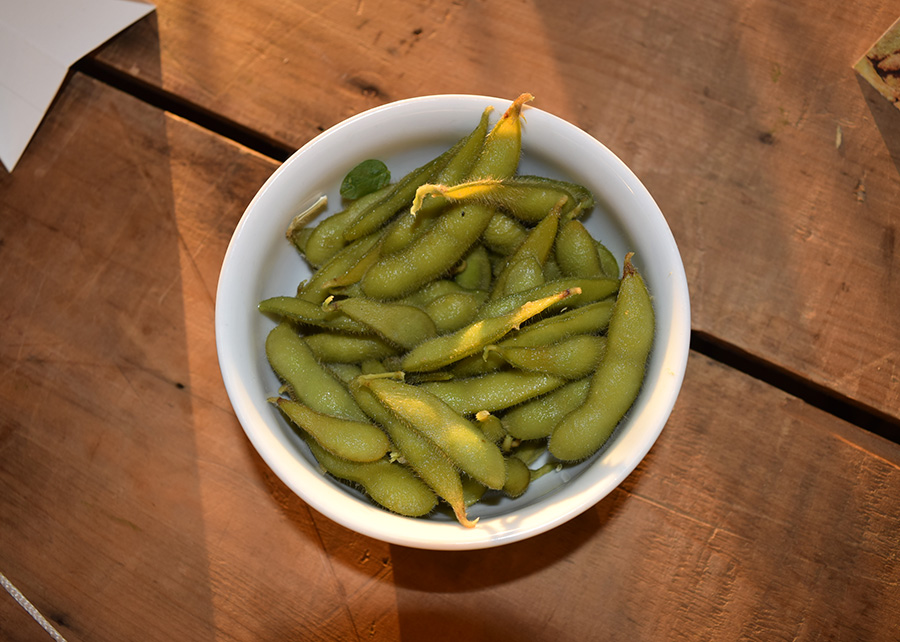 Seed companies can obtain BRS 267 licensing Seed companies can obtain BRS 267 licensing
In order to meet the needs of smallholders (organic and horticultural farmers), Embrapa is strengthening the organization of the seed supply chain for the production of edamame soybeans. During the initial stage, the Corporation is working on two fronts: assisting farmers that are already participating in the program and validating the production technology of edamame; and organizing the seed supply chain for the market, aiming to expand supply. Technicians recall that the technology is destined to a market niche that requires special attention, since the grain is directly consumed and there is value aggregation, and it also involves segregation in seed production. In the 2020/21 crop season, the Corporation carried out the production of the genetic seed of the cultivar, which is later offered to companies and seed farmers that work in the market. In this supply logistics chain, such farmers increase the volume in the following seasons and start to offer the seed of the cultivar to sellt o other farmers. Embrapa is already doing business with other two companies, but remains open to new partnerships to license the material. Seed production companies that are interested in multiplying seeds from BRS 267 can get more information about the cultivar on Embrapa's business web page. In addition to BRS 267 cultivar, Embrapa's breeding and genetic improvement program has a line of development of materials that are specific for human consumption. "The new cultivars that are being developed aim to provide other opportunities for farmers to work in different markets," Moreira underscores. |
Kadijah Suleiman (MTb 22.729/RJ)
Embrapa Food Technology
Press inquiries
agroindústria-de-alimentos.imprensa@embrapa.br
Collaboration:
Embrapa Soybean - Carina Rufino MTb 3914/PR
Press inquiries
soja.imprensa@embrapa.br
Translation (English): Luís Filipe Escobar, supervised by Mariana Medeiros
General Secretariat
Further information on the topic
Citizen Attention Service (SAC)
www.embrapa.br/contact-us/sac/



